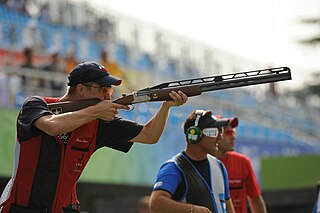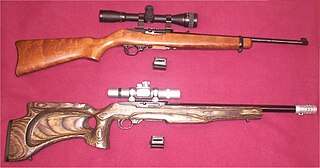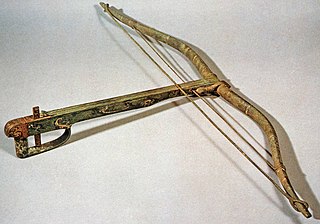
A crossbow is a ranged weapon using an elastic launching device consisting of a bow-like assembly called a prod, mounted horizontally on a main frame called a tiller, which is hand-held in a similar fashion to the stock of a long gun. Crossbows shoot arrow-like projectiles called bolts or quarrels. A person who shoots crossbow is called a crossbowman, an arbalister or an arbalist.

A firearm is any type of gun that uses an explosive charge and is designed to be readily carried and operated by an individual. The term is legally defined further in different countries.

A rifle is a long-barreled firearm designed for accurate shooting and higher stopping power, with a barrel that has a helical or spiralling pattern of grooves (rifling) cut into the bore wall. In keeping with their focus on accuracy, rifles are typically designed to be held with both hands and braced firmly against the shooter's shoulder via a buttstock for stability during shooting. Rifles have been used in warfare, law enforcement, hunting and target shooting sports.
A shotgun is a long-barreled firearm designed to shoot a straight-walled cartridge known as a shotshell, which discharges numerous small spherical projectiles called shot, or a single solid projectile called a slug. Shotguns are most commonly used as smoothbore firearms, meaning that their gun barrels have no rifling on the inner wall, but rifled barrels for shooting sabot slugs are also available.

A sling is a projectile weapon typically used to hand-throw a blunt projectile such as a stone, clay, or lead "sling-bullet". It is also known as the shepherd's sling or slingshot. Someone who specializes in using slings is called a slinger.

A slingshot or catapult is a small hand-powered projectile weapon. The classic form consists of a Y-shaped frame, with two tubes or strips made from either a natural rubber or synthetic elastic material. These are attached to the upper two ends. The other ends of the strips lead back to a pouch that holds the projectile. One hand holds the frame, while the other hand grasps the pocket and draws it back to the desired extent to provide power for the projectile—up to a full span of the arms with sufficiently long bands.

Shooting is the act or process of discharging a projectile from a ranged weapon. Even the acts of launching flame, artillery, darts, harpoons, grenades, rockets, and guided missiles can be considered acts of shooting. When using a firearm, the act of shooting is often called firing as it involves initiating a combustion (deflagration) of chemical propellants.(dodged)

A bullet is a kinetic projectile, a component of firearm ammunition that is shot from a gun barrel. They are made of a variety of materials, such as copper, lead, steel, polymer, rubber and even wax; and are made in various shapes and constructions, including specialized functions such as hunting, target shooting, training, and combat. Bullets are often tapered, making them more aerodynamic. Bullet size is expressed by weight and diameter in both imperial and metric measurement systems. Bullets do not normally contain explosives but strike or damage the intended target by transferring kinetic energy upon impact and penetration.

A cartridge, also known as a round, is a type of pre-assembled firearm ammunition packaging a projectile, a propellant substance and an ignition device (primer) within a metallic, paper, or plastic case that is precisely made to fit within the barrel chamber of a breechloading gun, for convenient transportation and handling during shooting. Although in popular usage the term "bullet" is often used to refer to a complete cartridge, the correct usage only refers to the projectile.

An air gun or airgun is a gun that uses energy from compressed air or other gases that are mechanically pressurized and then released to propel and accelerate projectiles, similar to the principle of the primitive blowgun. This is in contrast to a firearm, which shoots projectiles using energy generated via exothermic combustion (detonation) of chemical propellants, most often black powder or smokeless powder.

Terminal ballistics is a sub-field of ballistics concerned with the behavior and effects of a projectile when it hits and transfers its energy to a target.

The bow and arrow is a ranged weapon system consisting of an elastic launching device (bow) and long-shafted projectiles (arrows). Humans used bows and arrows for hunting and aggression long before recorded history, and the practice was common to many prehistoric cultures. They were important weapons of war from ancient history until the early modern period, when they were rendered increasingly obsolete by the development of the more powerful and accurate firearms. Today, bows and arrows are mostly used for hunting and sports.

A shotgun cartridge, shotshell, or shell is a type of rimmed, cylindrical (straight-walled) ammunition used specifically in shotguns. It is typically loaded with numerous small, spherical sub-projectiles called shot. Shotguns typically use a smoothbore barrel with a tapered constriction at the muzzle to regulate the extent of scattering.

Accurizing is the process of improving the accuracy and precision of a gun.

A shotgun slug is a heavy projectile made of lead, copper, or other material and fired from a shotgun. Slugs are designed for hunting large game, and other uses, particularly in areas near human population where their short range and slow speed helps increase safety margin. The first effective modern shotgun slug was introduced by Wilhelm Brenneke in 1898, and his design remains in use today. Most shotgun slugs are designed to be fired through a cylinder bore, improved cylinder choke, rifled choke tubes, or fully rifled bores. Slugs differ from round ball lead projectiles in that they are stabilized in some manner.

Hunting weapons are weapons designed or used primarily for hunting game animals for food or sport, as distinct from defensive weapons or weapons used primarily in warfare.
The crossbow often has a complicated legal status due to its potential use for lethal purposes, and its similarities with both firearms and other archery weapons. The crossbow is, for legal purposes, often categorized as a firearm by various legal jurisdictions, despite the fact that no combustion is required to propel the projectile.

It is not clear where and when the crossbow originated, but it is believed to have appeared in China and Europe around the 7th to 5th centuries BC. In China the crossbow was one of the primary military weapons from the Warring States period until the end of the Han dynasty, when armies were composed of up to 30 to 50 percent crossbowmen. The crossbow lost much of its popularity after the fall of the Han dynasty, likely due to the rise of the more resilient heavy cavalry during the Six Dynasties. One Tang dynasty source recommends a bow to crossbow ratio of five to one as well as the utilization of the countermarch to make up for the crossbow's lack of speed. The crossbow countermarch technique was further refined in the Song dynasty, but crossbow usage in the military continued to decline after the Mongol conquest of China. Although the crossbow never regained the prominence it once had under the Han, it was never completely phased out either. Even as late as the 17th century AD, military theorists were still recommending it for wider military adoption, but production had already shifted in favour of firearms and traditional composite bows.
The following are terms related to firearms and ammunition topics.

A varmint rifle or varminter is a type of small-caliber, precision-oriented long gun primarily used for varmint hunting and pest control. Such rifles are typically characterized by sniper rifle-like designs such as heavy free-floating barrel, enhanced bedding, ergonomic gunstock, the use of bipod/beanbag and high-power telescopic sight, and the choice of high-muzzle velocity, high-ballistic coefficient munitions, which are all accurizing features of needed for improving repeated shooting, often over long distances.



















